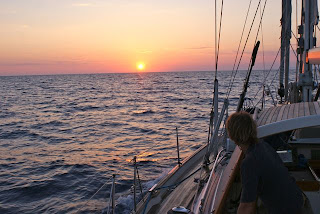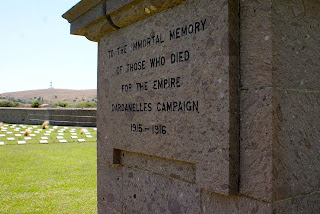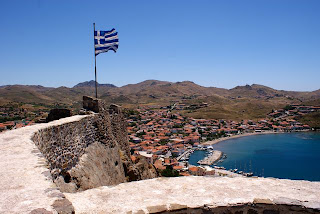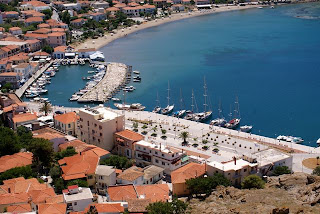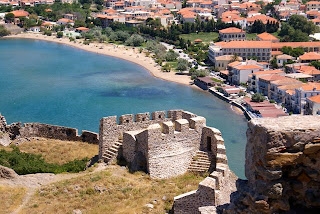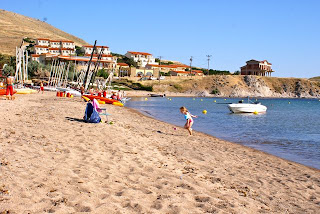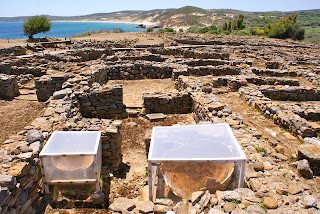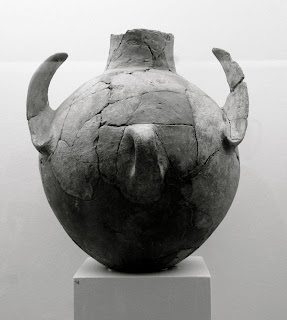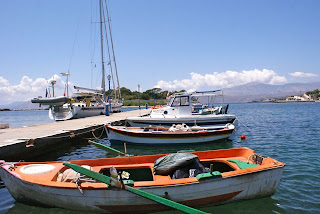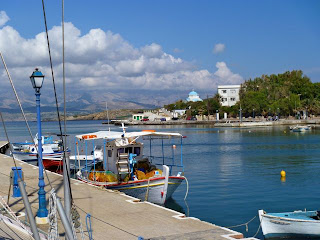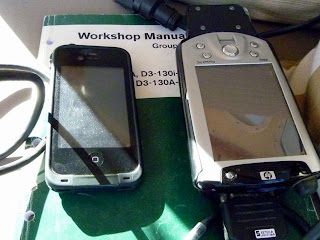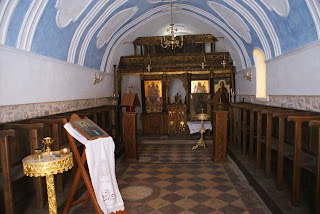 |
| Enki at anchor (furthest out) in Aliki, on Thasos |
You'd think that with the VP engine running at full capacity again (Alex plugged in the new sensor, the red flashing light and alarm disappeared and it was business as usual), all would be sweetness and light aboard Enki. Just one plate of grilled octopus after another, is what you're thinking, and top up the ouzo while you're at it.
That would be to forget that human beings are every bit as unreliable as machines. They too break down unexpectedly after hours of faultless running. They too need to be pulled apart, cleaned and put back together again.
 |
| Alex works on - and fixes - the Tohatsu 5 hp outboard |
We ought to have had a blissful time in Thasos. But we almost left the island on different vessels. That had nothing to do with Thasos, which has everything we go out of our way to find - peaceful, sandy anchorages, a rich ancient history full of surprises and a quiet port with room to manoeuvre. I'd go there again in a flash.
 |
| At Aliki, on Thasos, an entire headland of marble was quarried away before Jesus was born |
 |
| How they hoisted Thasos marble onto ships in the old days |
 |
| The rounded stone is what remains of an ancient hoist |
But after all the energy we expended to get north, we cleared out of Thasos after only three days, bound for the monastic coastline underneath Mt Athos and the Sinthonia peninsula beyond that.
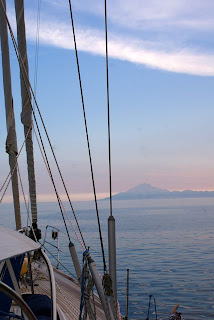 |
| Mt Athos, seen from the anchorage in Aliki |
 |
| Monasteries (above and below) on east side of Athos peninsula |
I won't say we were looking for spiritual cleansing. That would be far too romantic. But we had to leave the bad air behind us, that's for sure.
 |
| We ducked into this bay to shelter from a squall on the way up to Thasos port |
 |
| Approach to cape below Mt Athos |
We found what we were looking for in fresh north-easterly winds and confused, rolly seas along the east coast and around the bottom of the Athos peninsula. Distraction by sailing. Tried and true method of clearing your head. By the time we cleared the notorious cape under Mt Athos, we'd been joined by a school of pint-sized dolphins. They travelled east with us for several miles, criss-crossing under the hull, leaping and diving as the boat rode the swell and the wind like a spirit set free. We slipped into a quiet anchorage behind Dhiaporos Island, up in the gulf of Sinthonia, 12 hours after leaving Thasos.
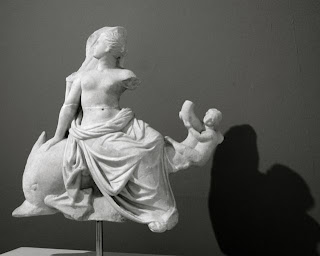 |
| Marble sculpture in Thasos museum |
I mention all this because neither our pictures of Thasos, nor those of Mt Athos and its monasteries, tell the whole story. In time, the pictures will become the only story we'll remember. We'll have forgotten the emotional gales. I think of that when I read the blurbs in museums (there is a particularly fine museum in Thasos). What do we really know about these people? What can a wall or a shrine, a bust or a pot, or even a skeleton, for that matter, tell me about their feelings for each other? For feelings, I have to go back to literature which is why I keep going back to literature.

I walked up the hill above Thasos port very early in the morning, leaving Alex to sleep. He needed his sleep, as much as I needed to walk. From the theatre, which is being restored, I walked on to the medieval fortress (another one built over ancient ruins by the Genovese), and looked out to the island of Samothrace in the east, and to the north, to the mountains of Thrace. Below me was Enki, and Alex, in the "new" harbour, one of the many unfinished projects which we have seen in each place we go.
 |
| Thasos port - Enki is parked just behind the red ferry |
Further up, on the way to the acropolis, I met a French woman called Manuela who was directing two men who were digging dirt from a trench between two walls on the site of an ancient sanctuary of Athena. It wasn't easy to find men who would work in this heat, she said, but they'd made an early start, had brought an umbrella and they would knock off at 2pm, as people do. They would dig down to the foundations, about 2 metres, she guessed. Why? She wanted to know how old the wall was. It was not as old as others had thought, she suspected. She explained her theory to me. It had to do with slits in walls and men firing arrows. It was important to her to know about this wall. You could see it in her eyes. She loved her work.
 |
| Hot dirty work in the sanctuary of Athena |
Manuela (an "architect of excavation") suggested I walk back to the town via a staircase of ancient marble which dropped down off the acropolis and then follow the city walls. I could go through any of several gates.
 |
| Ancient steps leading down to Thasos town from the acropolis |
 |
| Gate of Silene - or so I think |
In the 5th century BC, 20,000 people lived in this city on Thasos, more than the island's entire population today. They mined gold, traded slaves, married and raised children, goats and sheep, and built walls and harbours and temples as if their lives depended on it, which they did. I trod on their stones, and could only imagine their emotional gales.
Our story on Thasos, our blow-out, was a follow-on from other stories, the same kinds of stories people have been telling to and about each other for millenia - of my impatient nature, sharp tongue and weak grasp of sequential thinking, of Alex's stern, broad shoulders on which falls the full weight of practical problem-solving on the boat and of his back which stiffens at any suggestion of that weight being too much, of our not speaking Greek and of Greeks not understanding our expectations .... and more, all of which add up to a sense of not being in control. Of being vulnerable. All at sea.
 |
| Pan in his shrine on the acropolis above Thasos port |
Pan is the god of...panic. Here he is, still set in stone as he's been for 2500 years, in an olive grove above Thasos. The point of doing what we're doing at this time of our life is to step beyond our known world, and in doing so, stave off stagnation, that curse of middle age. Don't panic.
There's a point - and at Thasos we reached such a point - when you understand that you've been torn and patched a few times too many, and that your emotional fabric doesn't have as much give as it once did. You don't want to put it under too much strain, you don't want it to tear. You don't want that at all. You've got to treat each other kindly, especially when you're at sea, and wait for the next plate of octopus, which will come.




















